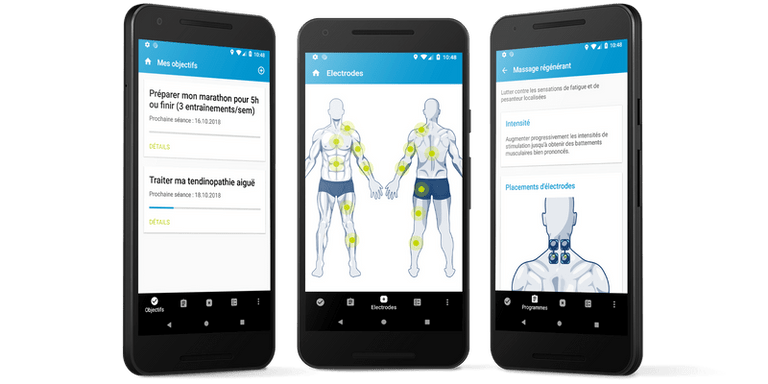As a digital agency, we have a wide range of business skills, from custom web or mobile development to user experience, content, and analytics. Our expertise enables us to respond to our client’s needs and problems.
Diving into complex topics to identify the challenges
To do our job as successfully as possible, we first need to understand the specifics of a company and its professional field, no matter how complex it may be. This means diving into a new world, its methodology and specific terminology, which some also call jargon. Sometimes it even means familiarising ourselves with restrictive regulatory matters, particularly in the fields of energy or MedTech – areas that we already work in.
Compex, an app considered to be ‘software as a medical device’
Our clients in the MedTech field include Enovis, a company working in medical technology that develops, manufactures and distributes medical devices and provides services in the patient care continuum – from preventing injuries to replacing joints and rehabilitation after surgery or injury. Compex, a leading Swiss brand in electro-stimulation in sports training, is part of the Enovis universe. They recently launched a new range of products that use a smartphone and app as an interface. In close collaboration with their R&D based in Ecublens (VD), we created this interface that allows Compex users to to understand their product better.
The app developed for Compex is considered an accessory for a medical device. While it is software with a well-researched medical objective, it also has potential health consequences related to using it. Let’s take the example of an app used to monitor a patient’s insulin levels. If it had a bug, providing wrong information, that would alter the treatment of their condition and have serious consequences. In the case of Compex, poor development or a fault in the app could not result in injury as the device fully mitigates the risks.
However, as an accessory for a medical device (therefore making up part of its architecture), the app has to adhere to the same constraints. To limit health risks, this specific type of software has to follow strict regulations – in particular, the IEC 62304 standard on the life cycle requirements for medical device software. Its objective is to structure all of the steps in the software’s development and maintenance life cycle to identify, isolate and ultimately reduce the health risks. The life cycle steps must be precisely documented in order to prove this standard has been implemented.
What this standard means in terms of development and responsibility
Unlike the other standards managed by our client, the requirements of the IEC 62304 standard that directly concern our work as developers must be met by us. This implies the necessary precision to integrate the client's requirements and meet all the quality criteria. We are not certified to IEC 62304; this responsibility lies with the client. However, we thoroughly understand this standard and use the tools that are most able to meet the requirements, whether to ensure deployments, integration or verification tests, or even to track and then integrate any changes. And ultimately, it helps our client to follow the compliance process.
We are fully aware of our responsibility in analysing the risks associated with this medical software. We help determine some of these risks on an ongoing basis throughout the development process. Any changes in our analysis are systematically communicated. And, of course, if this does happen, we implement solutions for reducing the risks.
This IEC 62304 standard is compatible with our agile working methods and tools, even though it was developed using a waterfall project management. The examples given in the documentation are projects managed in this style. But the standard we have been discussing here is only one of many regulatory requirements in MedTech. Some are more restrictive regarding the specific features described at the beginning of a certification process that could last years. This involves having a detailed description of the outline of the software at the beginning of the development process. This is a challenge for our agile approach, something we will come back to in another article.
Understanding your business to provide you with the full added value
This very particular field of software as a medical tool has allowed us to familiarise ourselves with this highly regulated, complicated and exciting industry. It is proof – if any were needed – that one of the business skills that is sometimes underestimated is to start by immersing yourself in a new professional environment. We do this to understand its challenges and constraints and to see how these would impact our work. This ultimately enables us to provide simple solutions tailored to complex problems.
And it isn't just us who thinks this. We’ll let Nicolas Fontaine, Director of R&D, Recovery Sciences of Enovis, have the last word: ‘The app developed with Liip is the result of a successful collaboration between our two teams. We are proud of the result, as it allows our users to interact with the electro-stimulator in an effortless, clear and reassuring way. In addition to security, it is also essential that our devices instill confidence in our users and give them a sense of control. ’
Do you work in the MedTech field? We can help you develop a tool that fully meets the needs of your users and the quality standards required in your industry.

